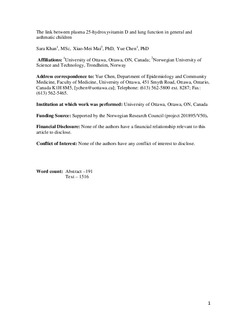| dc.contributor.author | Khan, S | |
| dc.contributor.author | Mai, Xiao-Mei | |
| dc.contributor.author | Chen, Yue | |
| dc.date.accessioned | 2017-06-12T09:29:24Z | |
| dc.date.available | 2017-06-12T09:29:24Z | |
| dc.date.created | 2014-10-01T14:55:47Z | |
| dc.date.issued | 2014 | |
| dc.identifier.citation | Pediatric Allergy, Immunology, and Pulmonology. 2014, 27 (2), 87-91. | nb_NO |
| dc.identifier.issn | 2151-321X | |
| dc.identifier.uri | http://hdl.handle.net/11250/2445758 | |
| dc.description.abstract | Vitamin D has been shown to play an important role in many bodily functions including the proper functioning of the respiratory system in adults. However, very little epidemiological evidence is available examining the relationship between vitamin D and pulmonary function among children. Our study examined the association between plasma 25-hydroxyvitamin D [25(OH)D] and pulmonary function in children. We used cross-sectional data from 1,421 children aged 6–17 years who participated in the Canadian Health Measures Survey (CHMS) in 2007–09. Multiple linear regression analysis was used to examine the association in the general children population and children with asthma. The data showed that 20% of children had plasma 25(OH)D concentration below 50 nM, which is classified as deficient. Linear regression analysis showed no significant association between 25(OH)D and lung function testing variables after adjustment for confounding factors in the general children population. However, data demonstrated a positive association of plasma 25(OH)D with FEV0.75, FEV1, and FEV1/FVC among boys with asthma. In summary, there was no significant relationship between plasma 25(OH)D and pulmonary function among the general children population; however, in boys with asthma, plasma 25(OH)D had a positive relationship with respiratory function. | nb_NO |
| dc.language.iso | eng | nb_NO |
| dc.publisher | Mary Ann Liebert | nb_NO |
| dc.relation.uri | http://online.liebertpub.com/doi/pdf/10.1089/ped.2013.0312 | |
| dc.title | The Link Between Plasma 25-Hydroxyvitamin D and Lung Function in General and Asthmatic Children | nb_NO |
| dc.type | Journal article | nb_NO |
| dc.type | Peer reviewed | nb_NO |
| dc.description.version | acceptedVersion | nb_NO |
| dc.source.pagenumber | 87-91 | nb_NO |
| dc.source.volume | 27 | nb_NO |
| dc.source.journal | Pediatric Allergy, Immunology, and Pulmonology | nb_NO |
| dc.source.issue | 2 | nb_NO |
| dc.identifier.doi | 10.1089/ped.2013.0312 | |
| dc.identifier.cristin | 1160504 | |
| dc.relation.project | Norges forskningsråd: 201895 | nb_NO |
| dc.description.localcode | This is the authors' accepted and refereed manuscript to the article. Final publication is available from Mary Ann Liebert, Inc., publishers http://dx.doi.org/10.1089/ped.2013.0312 . Postprints must not be used for commercial purposes. | nb_NO |
| cristin.unitcode | 194,65,20,0 | |
| cristin.unitname | Institutt for samfunnsmedisin | |
| cristin.ispublished | true | |
| cristin.fulltext | postprint | |
| cristin.qualitycode | 1 | |
